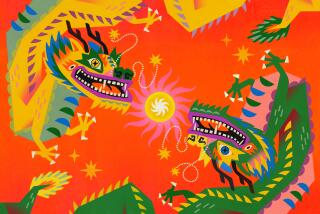Dance Troupe to Perform at Pacific Asia Museum to Mark New Year
- Share via
The Year of the Rabbit is over. May the Horse be with you!
Celebrants of the Chinese New Year, which began Jan. 27, may well breathe a sigh of relief at the transition.
According to Winston Lau, principal of the Northridge Chinese School, the Year of the Rabbit was particularly appropriate for the begetting of children.
“You know rabbits,” he says.
The Year of the Horse, on the other hand, is expected to herald somewhat more material forms of prosperity.
To mark the Chinese New Year, Lau will take the Northridge Lion Dancing Troupe to Pacific Asia Museum this afternoon.
The Lion Dance will be performed today as part of the museum’s “Free Day Fun Day,” held from 1 to 3:30 p.m. on the third Saturday of each month.
The dancers, who, with musical accompanists, number eight or nine children and adults, will strut their beastly stuff twice--at 1 and 2 p.m.
The lion, says Lau, is a symbol of prosperity in Chinese mythology, and it does an excellent job of warding off evil spirits.
“It also takes fewer people to operate the lion than, say, a dragon,” he says.
“For dragons you need maybe 50 people. There are, however, only 80 children in our school. A lion only needs three people to rotate the head and three to rotate the tail, so this is much more practical.”
Also during today’s program Gary Toy, a Los Angeles martial artist, will demonstrate ancient combat forms and techniques and deliver a short lecture on the history of martial arts and their role in traditional Chinese society.
Gerow Reece, a noted Chinese calligrapher, will conclude the museum’s New Year’s celebration with a hands-on demonstration of the delicate art of inking Chinese ideograms. Materials are being provided by the museum’s Chinese Arts Council, which is co-sponsoring the event.
The Chinese New Year rotates among 12 animals, notably the rat, cat, tiger, serpent, pig and, of course, those frisky hares.
The first week of celebration generally is reserved for activities largely restricted to members of the Chinese community, says Lau.
Traditionally on New Year’s Eve there are parties, whereas New Year’s Day--which this year fell on a Saturday--is a time for fasting and quiet reflection. People visit their elders to pay their respects, says Lau, while children seek scarlet envelopes containing “lucky money.”
Chinatown also throws its yearly New Year’s parade, which has become a colorful and dependable tourist attraction. This year, Chinese song and dance troupes as well as cultural, martial arts, scholastic and sports clubs marched down Broadway, while energetic wire and papier-mache dragons and serpents danced at their feet.
Earlier this week, members of the Chinese community also attended a series of traditional yearly banquets at restaurants and private halls in Chinatown, the San Fernando Valley, Monterey Park and Puente Hills.
* Pacific Asia Museum, 46 N. Los Robles Ave., Pasadena; (818) 449-2742.
More to Read
The biggest entertainment stories
Get our big stories about Hollywood, film, television, music, arts, culture and more right in your inbox as soon as they publish.
You may occasionally receive promotional content from the Los Angeles Times.










